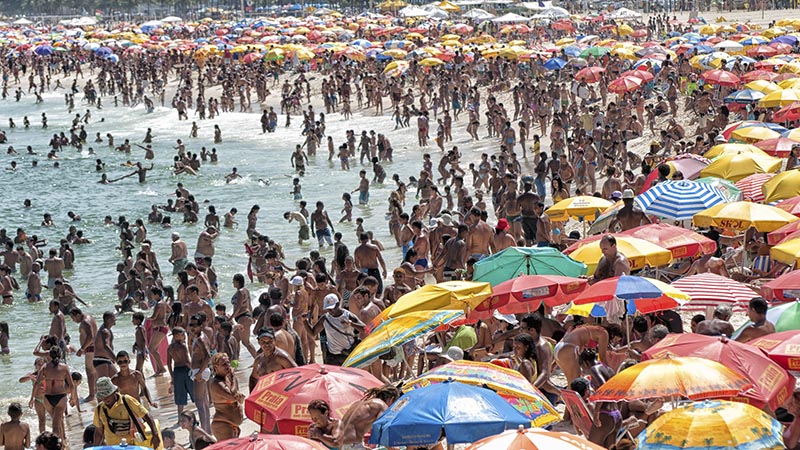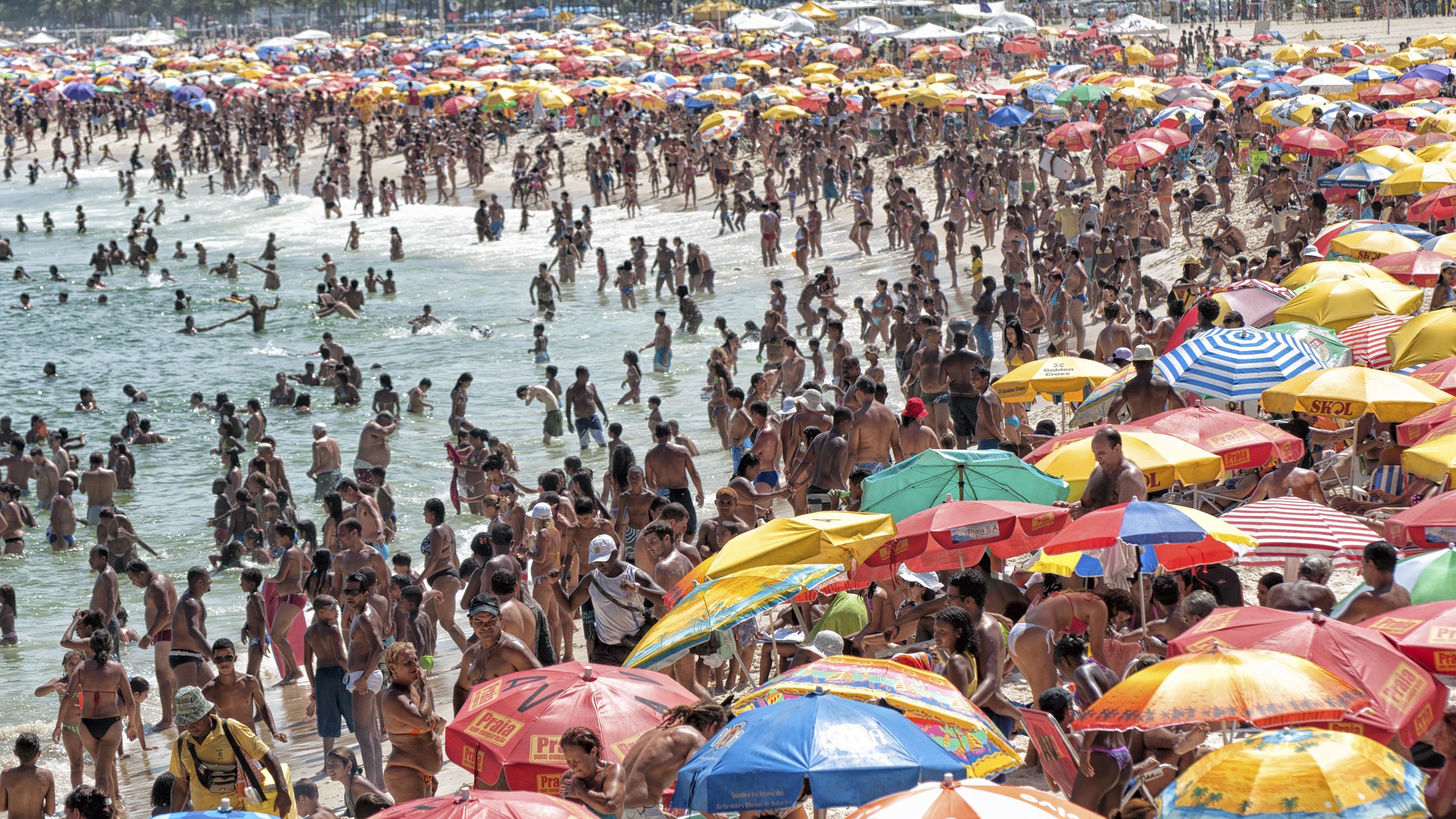Rio’s Olympic-Sized Health Problem
When Rio de Janeiro won the bid to host the 2016 Olympic Games, the Brazilian city pledged to clean up 80 percent of the raw sewage and trash that ends up in Guanabara Bay and the ocean waters that lap onto nearby beaches. But of the eight treatment plants promised, only one has been built, and the bay still bobs with trash — just six weeks before the games are scheduled to get underway on August 5th.

Copacabana beach in Rio is often teeming with beachgoers, but it might also have a lot of unwelcome viral and bacterial visitors. (Visual by iStock.com)
While Olympic authorities claim the waters are safe enough to compete in, independent testing by the Associated Press confirmed what Brazilians have known for decades: Rio’s waters are rife with viruses and bacteria that are dangerous to human health.
Of course, human waste will always contain a large viral load that can infect anyone who comes into contact with it, according to Joan Rose, the chair of water research at Michigan State University. But tests that detect viral load only confirm the presence of viruses, not whether they are alive or dead.
Viruses are also affected by temperature — a water-borne virus is often killed off in heat or salty water. By way of example, Rose pointed to sampling she completed in the Florida Keys.
When she tested for viruses in the water, 85 percent of the samples were positive. Yet when her team looked at whether the viruses could be cultivated in a lab — a test that would show whether the viruses were alive — Rose found that the virus load varied dramatically depending on the water temperature.
“In the summer we couldn’t find [live viruses],” says Rose. “In the winter we could.”
Rose says this bodes well for Rio this summer. “The waters in Rio are fairly warm; they’re saline,” says Rose. “If we can predict the temperature, we could get an estimate of the die-off rate.”
Still, the sheer volume of viruses in Rio’s waters remains a cause for concern, said Kristina Mena, who studies environmental science and health risk at the University of Texas School of Public Health. “The levels of virus are similar to what’s in raw sewage,” says Mena, who independently evaluated the Associated Press’ study. The lab that completed the study used molecular techniques to test the samples for virus, says Mena. Several samples were tested using cultures, which confirms that the virus in those samples was alive.
Regardless of whether the viruses are alive or dead, says Mena, the load in Rio is “so high that it’s highly likely that someone’s going to be infected.”
That infuriates Renata Picão, a professor in medical microbiology at the Federal University of Rio de Janeiro. “They continue to pollute and nothing has changed,” she said. “We lost the once-in-a-lifetime opportunity to change it.”
Picão and her fellow researchers have been sampling for bacteria around Guanabara Bayand and the city’s surrounding beaches. Although the results are still undergoing peer review, Picão says she found varying concentrations of several different species of drug-resistant bacteria in beaches near Copacabana, Botafogo, Flamengo, Ipanema and Leblon. Looking at marine pollution and environmental factors like rainfall, water temperature, and salinity, Picão found that polluted waters are the strongest indicator for high concentrations of the drug-resistant bacteria, which include species in the Pseudomonas, Acinetobacter and Aeromonas genera, as well as members of Enterobacteriaceae, many of which are resistant to carbapenems, one of humanity’s most powerful antibiotics.
According to the CDC, three of these four bacteria are considered urgent or serious threats.
Picão’s investigation builds off of other work that surveyed marine bacteria in Rio de Janeiro and showed a correlation between pollution and the spread of drug resistance, as well as some of her own research that showed wastewater from hospitals was releasing drug-resistant bacteria into the environment.
“Here in Rio, we have lots of hospitals that do not treat their sewage before disposing of it,” she said. “We also cannot treat all the sewage we generate. It goes into rivers and in the end, the bay.”
While it is not uncommon for cities to dispose of raw sewage in bodies of water — according to a 2010 United Nations Environment Program report, 90 percent of all wastewater in developing countries is released untreated — Rio’s sister city, Niteroi, which sits across the bay, treats 95 percent of its sewage. Rio de Janeiro allegedly treats about half of its wastewater.
With her latest study, Picão has identified drug-resistant bacteria in Rio’s waters that are nominally suitable for bathing. While this could present a health hazard for Olympic athletes, she is hesitant to conclude anything — in part because little is known about how drug-resistant bacteria behave in marine environments, she said. There have, however, been reports of stomach illness and MRSA that occurred after Olympic test events in Rio last year.
“We don’t know what concentration in the sea will reflect an infectious dose,” Picão said, pointing out that in water, drug-resistant bacteria may behave wholly differently than they do in a clinical setting. “We don’t know yet the impact on public health.”
She did say, however, that levels of “medically-relevant super-bacteria” in Copacabana, where the Olympic triathlon is set to take place, were extremely low.
Still, several outstanding questions could affect how far the bacteria spread and how virulent they become. For one, scientists don’t know if these species can replicate in saltwater. Secondly, it’s unclear whether the drug-resistant bugs are being outcompeted by marine bacteria, or if they are continually being replenished by untreated sewage sources. And thirdly, it could be the case that they’re conferring antimicrobial resistance to native marine bacteria by passing along their resistance genes.
“This is a problem for the evolution of microbial resistance, and this may have consequences on humans and the environment,” Picão said.
“Other people should be looking for these bacteria because it’s not only happening in Brazil.”











Comments are automatically closed one year after article publication. Archived comments are below.
beaches remain crowded semanalmentec, this super bacteria talk is pure sensationalism, if there would be interdicted this story